I missed Julian Bleecker‘s talk at eTech not just because i was in another room listening to Michael Frumin and Michal Migurski (more on that one later) but mostly because Julian had promised to give me a small re-run of his talk the day after. Which he did.
So i wrote with zeal while he was re-performing, had a look at Oren Sreebny, Elizabeth and Michael‘s notes, at Julian’s blog entry and at his slides and here’s what i’ve got:
Pervasive Electronic Games: Theory Objects For Social Play.

The main point was to figure out how to describe pervasive games as a way of creating, understanding and researching social interactions and the relationship between we and the worlds we inhabit.
Many things in our environment can become playful, the whole city can be a big playboard. How can we play off with the existing infrastructure? Pervasive gaming is all around us, it touches many parts of our everyday life. Its manifestations don’t have to be physical either. The networks leak into our world. Pervasive networks pervade our physical space but they also pervade our social space and shape daily social practice.
Pervasive games need not be super high-tech. Take I Love Bees for example, it could be played with a traditional phone.
We need new metaphores to design these different kind of interfaces.
Games can provide different ways to look at the physical world.
Take the debris: we would normally ignore them, but games can turn them into components of the pervasive experience. It would lead to a different kind of awareness.

Pervasive play takes us into the network. It adjusts our perspective on the physical world, creating a renewed experience of what the world contains. Makes it difficult to look away from what we don’t like to see.
If one makes a game that rules that it’s ok to look at homeless people. Instead of looking away and ignoring them, you’d become aware of the problem. There’s then the possibility to try to make a better situation. Add a new perspective and can lead to new considerations as to what goes on in the world and how we can make it more sustainable.
New meanings can be found in hidden, unexpected corners. Game pieces can be found everywhere. The infrastructure is ludic. Annotation rewrites rules.
How can movement become a component of the game? Movement turns the game into something more physical, something that goes beyond the console. Social play should have another register of interaction and engagement beside sitting in a room with your friends. Will we, one day, look at the picture below and think that it was the Jurassic form of electronic game?
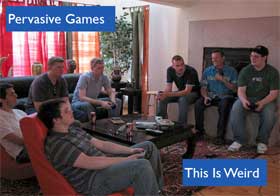
Games are theory objects that can reveal and shape human interactive rituals, they make us ask questions about how we interact in the physical world. Games can be used as a kind of research instrument to investigate how we move about and interact in the physical world.
Examples: Big Urban Game, ConQwest, Tokyo SuperStar (you have to “collect” people, it’s a non-competitive game, you get points by linking to people), Blast Theory‘s Uncle Roy All Around You.
Geocaching: Go Game, some rules but whimsical kind of experience, it brings people outside of themselves, turns external world upside down through performance – changing perspective
Mobile phone games: mobile phone can become an interface not for games on the screen, but for playing games that pervade the physical world. Casual play, goes beyond complicated technology barriers. How to excise the carriers out of the mobile media ecosystem?
Julian then made a small demo of his game clickr!, a compelling mobile game without the fancy tech. Anyone can play Clickr. It uses mobile phones to create a playful experience for people who are in the same physical space (a movie theatre, for example.)
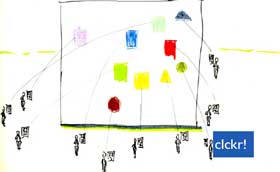
Clckr allows people to use their cell phones as a control device during the time prior to a movie to create a multiparticipatory entertainment interaction experience. From their theater seats, audience members can play an interactive game projected onto the theater screen using the keys of their phone handset to control on screen game pieces, fun visualizations and drawing applications, and participate in a multiplayer trivia contest.
Other examples Flirt – Stampede: A virtual herd of reindeer is loose on the network. Warnings go out to those in their path. The reindeer first appear on screen as small forms in the distance. They get progressively bigger until they fill the screen. Casualties are reported.
– The Lost Cat: Network users are told that the network cat has gone missing. In certain locations, the cat will appear on a mobile phone. The cat has a mind of its own: after a while it walks away. This game makes sense: you actually meet cats in the street, not a Pacman!
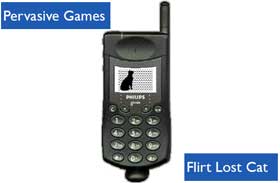 Twitcher: a virtual pet environment in which “…digital birds visit your mobile phone. An application that resides on your handset gives you a window onto a “virtual garden”, into which these birds will fly from time to time. To tempt them, you use an almost childishly simple one-click interface to drop pieces of seed on the ground; minutes or hours later, your handset flashes and tweets as a bird arrives, and you have a short window of opportunity to click again and snap a photo.”
Twitcher: a virtual pet environment in which “…digital birds visit your mobile phone. An application that resides on your handset gives you a window onto a “virtual garden”, into which these birds will fly from time to time. To tempt them, you use an almost childishly simple one-click interface to drop pieces of seed on the ground; minutes or hours later, your handset flashes and tweets as a bird arrives, and you have a short window of opportunity to click again and snap a photo.”
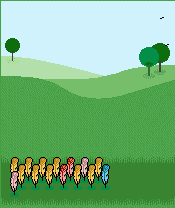
“If you configure Bluetooth and “pair” your device with that of a Twitchr-playing friend, then birds can fly between your phones” (…) “Once you’re online, your phone becomes part of a massive digital environment: numbers of the various species rise and fall over time, new species can be introduced, and old ones become extinct.”)
Julian’s Viewmaster of the Future (video).
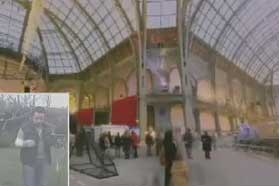 Human PacMan, an augmented reality version of the original arcade game;
Human PacMan, an augmented reality version of the original arcade game;
CatchBob!, a mobile game for running psychological experiments. It is designed to elicit collaborative behavior of people working together on a mobile activity;
Feeding Yoshi, players have to locate the Yoshis, which are actually secured wireless networks, represented as small creatures. Each Yoshi asks the player for a particular kind of fruit. TO get points, players must then grow and retrieve these fruits from plantations, which are actually unsecured wireless networks. Players are encouraged to interact with each other by swapping their fruit;
Piedimonsterz : monsters help motivate kids be more active. The service includes a physical device carried on the person (a virtual pet pedometer), a website which takes the data from the device and provides activity reports, and neighborhood hubs for organizing local group activities.
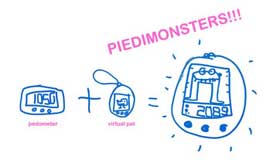 Conclusions:
Conclusions:
– Pervasive games create different perspectives;
– get us to look at the “real” habited world differently;
– create different points of view;
– maybe they can encourage us to think about making the world more habitable.
Image: Monkey Bites.
